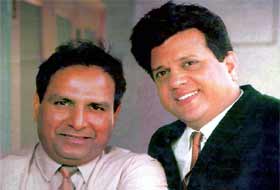


This interesting exercise was initiated after a colleague posted a Tennesse Ernie Ford song ‘Water Melon’ on the whatsapp forum. Yes S D Burman has adapted the tune for his ‘Hum The Woh Thi’ from Chalti Ka Naam Gaadi, but has cleverly added his own composition of the last 2 lines in the sign line (mukhda) which act as a bridge towards the stanza.
The question is, is this outright “Plagiarism or Inspired Attempt”?????
I feel a lot of music in the field is reproduced / born out of some parent tune. All the music composers listen to a lot of music of different kinds, some of these tunes are etched in their subconscious and can then surface as part of a song, say in the form of a line or two. This would be called inspired tune and a subconscious effort; hence the verdict in the above case is not guilty.
But a lot of Bollywood songs have been plagiarised in broad day light .There are some glaring examples of our "genius" Music Directors who have mastered the "art" of making a perfect copy-paste of tunes from overseas, reproducing it to the minutest detail! (The wise reader need not be told who they are, I guess!) Then there are the others who indulge in this copy-paste hobby sporadically, albeit they are capable of producing some very original and quality compositions - I am referring to the bandwagon from the late 20th Century!
Composers like Anil Biswas, Naushad, S.D. Burman and Salil Chowdhury adapted a lot of compositions from folk music. They should be commended for bringing forth the hitherto unheard folk music to the music world, albeit without giving due credit to the unknown folk music composers.
Bollywood music is rife with numerous anecdotes and stories of such "inspired" music. We, listeners are fortunate to have heard these wonderful tunes from different corners of the world.
It requires a lot of restrain to escape the allurement of copying a tune and then passing it off as one’s own figment of imagination, when it comes to the music industry and especially Bollywood, where patent laws have been virtually non-existent. The purpose of this article is not to discuss the patent laws but rather to explore the trait of plagiarism and the erstwhile music directors who fell prey to it.
Of course, the consequences were not always disastrous; rather a lot of times the result was the birth of a euphonious melody, probably due to the adroit improvisation and craftiness employed by the music director involved in the process.
Let us begin with one of the most popular musical duo of Shankar-Jaikishan (referred to as S-J) who reigned supreme from 1949 till the advent of 1970s.
A lot of SJ melodies have been based on Indian Classical Ragas, especially Bhairavi and Darbari which also feature as “scales” in Western / East European music (the Phrygian and Dorian scale respectively), but the influence appears to be more Western/East European. Honourable exceptions are pure classical songs like “Jaao Re Jogi Tum Jaao Re”, “Neel Gagan Ki Chhaon Mein”, ‘Jhanan Jhan Jhanake Apni Paayal”, “Jhanak Jhanak Tori Baje Payaliya or “Cham Cham Baje Re Paayaliyaa” and "Ajahu Na Aaye Balma", which were pure gold!
1. Ghar Aaya Mera Pardesi (Awara)
“Ghar aayaa mera pardesi” from is based upon an Egyptian song "Ala baladi El Mahboub". But it stands out due to its electrifying orchestration and the clever transfer of Arabic notes to Indian Scales!
The genius of S-J is evident in the fact that they only used a single line from this Waltz composition and made it into an interlude for the song!
“Kaun Hai Jo Sapno Mein Aayaa” from Jhuk Gaya Aasmaan is based on a wonderful song “Marguerita” by the flamboyant singer Elvis Presley
Aajaa Sanam Madhur Chandni Mein Hum” from Chori-Chori is influenced by a Naepolitan melody called Tarantella. S-J borrowed the sign lines of this melody and then went on to compose the stanza and the prelude as well as the interlude pieces and merged them very skilfully with the mukhda!!
Mohammed Rafi’s “Bin Dekhe Aur Bin Pehchane” from Jab Pyar Kisise Hota Hai is inspired by Ron Goodwin’s Dancing Eyes.
These are but a few examples of S-J inspirations. Compare these handful few to the huge number of melodies that they churned out and you would then realise the sheer genius of these musical duo. This article is in no way aimed to belittle this music director duo, but to shed light on those original melodies which are equally enchanting and have been adapted ingeniously to suit the tastes of the Indian audience. Hence let us pay a tribute to S-J for introducing us to global music and contributing in a huge manner to enrich our musical journey.